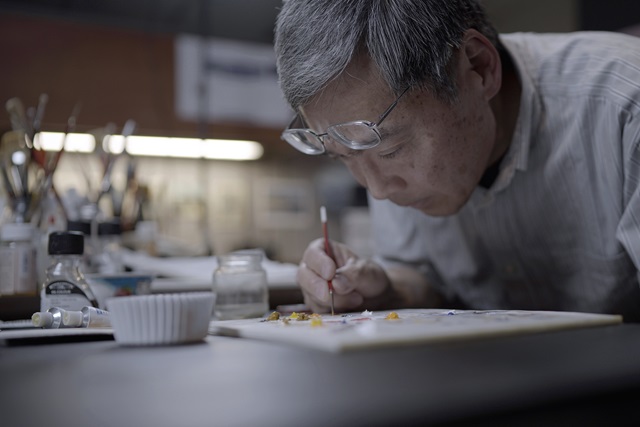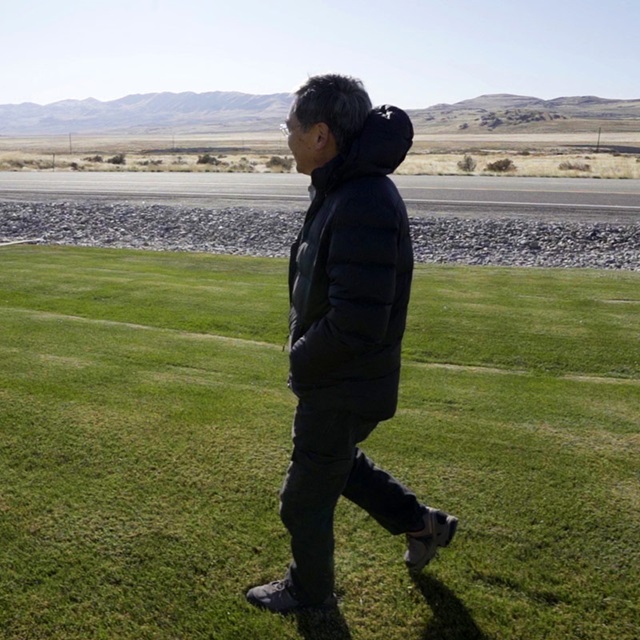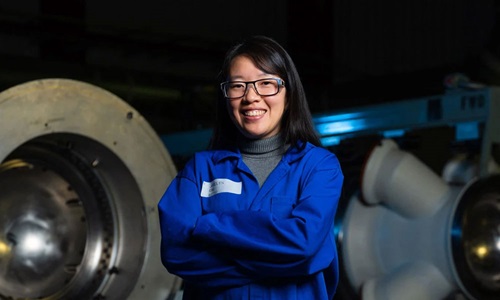Shape your career journey with diverse roles and experiences that expand your expertise, feed your curiosity, and fuel your passion.
By Adam Ugolnik
Throughout his childhood, Mark Waki wanted nothing more than to become a fighter pilot. With those dreams crushed due to poor eyesight, Waki was lost, searching for any opportunity to build a life around his greatest passion — military aircraft. A talented painter and model builder who grew up idolizing model box-top artists, Waki heeded the advice of a fellow model builder: he enrolled in art school and went on to become one of the most technically accurate aerospace artists of this time. Thirty-eight years after starting his first job, and with the most replicated painting of the Space Shuttle under his belt, I spoke with Waki about his life, career and opinions of the changing landscape of art in today’s aerospace industry. This piece has been edited for clarity.
Adam: Have you always been talented in the arts? Did that come naturally, or was it something you had to work at as a kid?
Mark: I started drawing when I was really little, so the art classes I took — they were effortless. Whenever I did any kind of assignment, the instructors would ask if I’d done them before. Whether it’s a talent, I don’t know. I always felt it was hard work.
Adam: Can you walk me through your creative process? Are you sitting down with an engineer who’s explaining to you what they’re looking for? Do they tell you about the product and you envision what it looks like?
Mark: It starts with the pilot. Most everything I do is a scene — with an airplane, it’s a combat scene. So, I talk to people who fly that type of mission. Then I think about how to create the scene so it’s technically accurate. If it’s possible to make it completely accurate with separations between airplanes and altitudes, then that’s what I’ll do. Of course, there are times when it’s impossible to put everything in the right view and make it technically accurate, so I’ll take artistic license and adjust things.
Adam: Do you sketch it small and then share that with them?
Mark: Yes. Initially, before computers, I would do 4 x 5 inch small oil paintings. I would do a bunch of those, and they would say, “I like this view a little better than that view, so let’s do that.” Now I do it all in Photoshop. Which, in a way, makes it tougher because Photoshop is so easy that I can do endless numbers of small compositions. So now it’s like, “I like this one, and I like this one and I like that one too.”
Adam: As a kid, what sparked the interest in planes? What was the catalyst to all of this?
Mark: You know, I can’t really pin that down. I remember there was an airshow in the early ’60s. That probably really set it off, but I’ve always had an interest in things that fly.
Adam: In your bio, you mention some of your favorite box-top artists — I’m curious how you came to discover them.
Mark: Well, in addition to the drawing, I was also an avid scale modeler when I was young. My parents bought me a plastic airplane kit around the same time I started getting interested in airplanes. They would get me kits of everything ... cars, tanks, airplanes, monsters ... I liked anything to do with models, but I liked airplanes the most.
Jack Leynnwood and John Steel were model box-top artists, so I would see their work on the box tops and I thought they were the best. But I discovered Keith Ferris near the end of high school. Keith would do ads for Chandler Evans and other companies in Aviation Week. I thought Keith was actually a step up because he was technically correct, whereas Steel and Lynwood didn’t need the technical accuracy because they did box art.
Adam: You had planned to become a pilot, I understand, but were limited by your eyesight. I’m curious how old you were when you discovered that your eyesight would impact this aspiration.
Mark: It was between my junior and senior years of high school. We were going through my possible career paths. I looked at every possibility and just knew that I wasn’t going to fly military planes. I was always good at math and science, so I decided to pursue an engineering degree, but I couldn’t pin down what I wanted to do. I was lost.
Adam: You attended University of Utah, and Utah Technical College ... what were your expectations at that time?
Mark: I focused on science and took all AP classes my senior year of high school. So my first year of college was sort of a repeat. Everything was easy. The teachers made me a teacher’s aide, so I had twice as much work. I started thinking, “Am I going to be able to do this for the next 40 years?” I was doing stuff that I wasn’t sure I wanted to make a career out of and having to do more of it because I was an aide helping other students. My first three quarters, I kept an almost 4.0 average, but then I just dropped right off. I think the interest just faded.
But I was in this model airplane club, and one of the guys in the club was an art instructor at Utah Technical College. I would sketch stuff and bring it in for the guys to see, and he said to me, “You need to go to school. You have talent!” So I went to technical school.
Adam: Did you enjoy that? Did you embrace the training?
Mark: I did for the most part. I would modify every assignment to somehow have something to do with airplanes. They said, “You’re never going to make it this way.” All the instructors said, “You will never make a career out of painting airplanes.” If I couldn’t paint aircraft, I didn’t know what I was going to do. The whole goal of going to school was to make a profession of painting airplanes. Keith Ferris was a professional aviation artist, and that’s what I wanted to be.
Adam: So how did you fall into your current position?
Mark: Another friend in the model airplane club was a professional model builder up at Northrop Grumman, or Thiokol at the time. He was going to quit, and he said I was absolutely perfect for that job. There wasn’t anybody else that had those modeling skills. So I said, “Well, I might as well go see what it’s all about.” I interviewed with my portfolio of artwork, and they said, “You’re in!”
Adam: What were your first impressions when you started? Was it a big adjustment for you?
Mark: You put a lot of effort into artwork or a model, but things changed so quickly, the old “don’t get attached to your work” saying really applied. What was current one day wasn’t current two weeks later. You had to constantly put work behind you and move on to the next thing. That was a little hard to get used to.
Adam: What were some of the very first projects they put you on?
Mark: I started right when the shuttle was brand new. I think it was a year and a half after the first flight, so it was mostly shuttle models.
Adam: Tell me what that was like for you ... You had grown up so fascinated with airplanes, and here you are, working on this next-generation spacecraft.
Mark: You know ... It was really interesting. The model building and the painting were second nature. But learning about the hardware made it the most interesting because I got to talk to the engineers and see drawings of the real hardware. And then get to go look at it.

Adam: What was that transition like from traditional painting and models to more computer-centric techniques? Did you get ahead of it? Were you training on computers, or was it just a sort of gradual evolution?
Mark: Digital illustration and computer-generated stuff was really interesting to me, so I jumped into it early. I spent a lot of time on it at home on my own time.
Adam: Tell me some of the greatest challenges that you’ve encountered.
Mark: Many of the things I’ve been asked to do, there just isn’t enough information on. Before the internet, there was no way to research something as simple as “What does a launch pad look like?” There was nothing to base it on. Now there’s Google Maps. I just go look and then cross-reference it to other photographs. But back in the early ’90s, there was nothing but ground-level photographs to work details out. It was hard to make things technically accurate.
Adam: What are some of the challenges you encounter on a day-to-day basis?
Mark: Lack of time. Before the customer comes to you, the deadline is already relatively close, so the working window is short. As I’ve worked here longer, that’s become less of a problem. But for model work and digital work, the working window is always extremely short. Improving your technique or knowledge of how to do things fast is extremely valuable.
Adam: You’ve been doing this 38 years now. How do you stay motivated and keep that flame lit?
Mark: I’m always looking at master painters, and there is still so much to learn. I feel like I need another 20 years to become a good painter. Aviation art and aerospace art will never be considered truly fine art, so I think my motivation is to inspire our fighter pilots, inspire our astronauts and inspire our engineers. To keep them interested, it’s got to be technically accurate.
Adam: Where do you see things going as far as the positions that artists hold within the aerospace industry? Do you see a continued need for artists?
Mark: I see a continued need for good artists. Due to the ease with which digital arts can be done, most digital artists I see are missing what makes art good. The typical way graphic artists do it now, without having illustration skills, is they’ll take photographs of different objects and put them together in one scene. The perspective doesn’t match, or the color’s off or the reflections don’t match. Things have a tendency to look like cardboard cutouts. Edges are hard, and there’s no depth. I think that’s simply because digital is easy to do.
Adam: If you’re painting a car, you can walk around it and look at it from different angles and perspectives. But when you’re painting a space shuttle launch, you really have to know what you’re doing.
Mark: I guess I’m lucky my brain works that way. When I put three-dimensional objects in space, I can picture how they look and can figure that out. The things you can do with paintings to give depth — bright and dull, warm and cool, light and dark ... Most digital artists don’t get those three primary things.
Adam: How many people with your skillset are you working with?
Mark: None.
Adam: So you’re the guy? That’s a lot of pressure on you.

Mark: I’m looking at retiring. It’s on the near horizon. We’re trying to figure out what critical things we need to train someone to take over. It’s quite hard, trying to train an illustrator ... you have to have the will and drive to be able to get good at it. Most artists aren’t interested in hardware. Because of the work here, the technical aspect is really important. It’s as important as being artistic. It’s hard to find people who can do both.
I think someone with an engineering background who has interest in producing art would be better served pursuing this. R.G. Smith was a full-blown engineer. He designed parts for the A-4 Skyhawk and everything. His artwork was on the side, but pretty soon, all the company executives started to say, “Hey, we’ll make you a painter.”
Adam: What would you say to those artists or engineers, just starting out, who might want to do what you do?
Mark: Maybe it’s a result of my parents’ generation and what they instilled in me, but I’d say, “Pursue what you want to do, and never give up. If you run into a hard spot, you just have to keep going.”
Adam: Did you meet a lot of those hard spots?
Mark: Yeah. There were a lot of tough spots. Just had to keep going.
Adam: What’s in your future? What do you look forward to doing in retirement?
Mark: I look forward to painting more. I have a list of about 50 airplanes I want to paint.
Northrop Grumman employees apply their talents in all areas of the business, including photography, design, communications, engineering, manufacturing, physics and more. Find out about open positions where you, too, can be creative and innovative.

